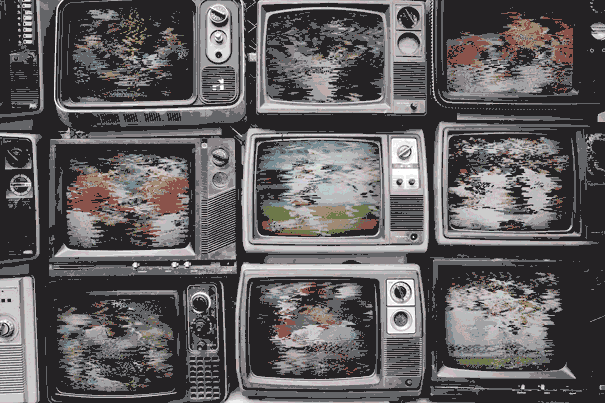HDTV Signals a New Era for Viewers
- Share via
Milton Berle, one of the first faces to appear in color on the small screen, made television history again last week in Los Angeles--this time from the control room at KTLA-TV Channel 5. The comedian flipped a switch at the station enabling viewers to receive a new digital signal that creates in its highest form crystalline, theater-quality pictures and sound known as high-definition television.
After nearly two decades in the laboratory and at the eye of a regulatory storm in Washington, high-definition television (HDTV) is finally ready for American living rooms. Many broadcasters see the move to digital as the biggest revolution in television since the advent of color in 1954, allowing the industry to join a parade of mediums from music to movies that have already embarked down this path.
Yet the beginning of this revolution won’t be as easy for consumers to understand as the shift from black and white to color. Few households witnessed this technological milestone because current TV sets won’t pick up digital signals. The price of a new set that will translate the signal runs about $7,000 and up.
And with a negligible audience, broadcasters have found themselves making large investments in new technology with uncertain returns.
The Revolution Begins
KTLA and three other stations in Los Angeles--KCBS, KABC and KNBC--are among more than 40 nationwide that began in the last few days to transmit their signals in state-of-the-art digital in addition to the old-style analog form. To encourage the transition to digital, the federal government gave broadcasters an additional slice of the airwaves at no charge on the condition they eventually give back the piece used for analog transmission.
Just as compact discs brought a leap in audio quality and allowed more sound to be packed into smaller packages, digital compression gives broadcasters new efficiencies, allowing them to offer consumers broader choices or three-dimensional HDTV pictures that some viewers liken to looking at scenery through a window.
A Computer Link
Digital technology could bring TV closer to the much-talked-about marriage with computers. Interactivity through simple clicking of a remote could allow viewers to see their favorite shows when they want, look up sports statistics during a game, order clothing worn by their favorite stars, or check traffic and weather reports.
Once stations learn the ropes of this new digital process, they may experiment with packing multiple channels into the space now occupied by one, or even leasing leftover spectrum. KTLA envisions news channels targeting Latinos or teenagers if additional advertising could be generated to justify splintering its existing audience.
“We’re looking at distributing Internet content and multicasting,” said Frank Geraty, director of broadcast operations and engineering at KTLA, which is owned by Chicago’s Tribune Co. “We are a newspaper company with lots of content to tap into. Nothing will replace our core business, but providing other services could bring in new revenues.”
At the moment, however, stations are concentrating on simply “upconverting” their standard analog signal to a digital form.
Only a smattering of true HDTV programming will be available in the near term, with much of it coming from CBS, ABC and PBS. On its virgin digital flight Sunday night, KABC aired “101 Dalmatians” in HDTV, one of 11 theatrical films scheduled by the network before the end of the year. CBS is producing four NFL games starting Nov. 8, and will shoot the Nov. 18 episode of “Chicago Hope” in HDTV.
KTLA and KCBS were the first stations in Los Angeles to air in HDTV on Thursday, picking up a special feed of John Glenn’s space reunion aired by more than 20 stations nationwide to kick off HDTV. The telecast was produced by two longtime champions of digital broadcasting, the Harris Corp., which is selling new digital transmitters to hundreds of stations, and WRAL, a CBS affiliate in Raleigh, N.C., that sent out the first commercial digital signal in 1996.
“On the timeline of American broadcasting, Thursday was a historic day,” said Steve Blue, director of operations and engineering at KCBS-TV Channel 2.
But whether the American public wants HDTV and how soon is unclear. The answer depends partly on how quickly prices drop on large-screen HDTVs and set-top decoding devices.
“Last week, I know there was at least one sold in L.A.--for $14,000,” said KTLA’s Geraty. “I hope there are others; we’re spending $24,000 extra a month in electricity to transmit in digital.”
The Good Guys store at the Beverly Connection mall near Beverly Hills has one of the biggest selections of HDTV sets in the area, with three brands on display. Video manager Luis Ramirez said eight sets have been sold or ordered so far.
Taking a Risk
Because so few people can receive the digital signal, broadcasters have yet to come up with business plans that will cover their investment in new technology. It costs at least $5 million to upgrade a station to digital.
Even so, many broadcasters see digital as a way for the industry to compete. “Everyone is afraid that the consumers won’t buy into it, but this is not the same old TV--and it could be a booster rocket in terms of maintaining our position in the market,” said KTLA’s Geraty.
The cable industry is quickly upgrading its systems to use digital technologies, and satellite services such as DirecTV have always transmitted digitally, using special boxes to convert their signals to today’s analog sets.
Digital images and sounds are clearer and brighter than their analog counterparts because they are broken into small bits before they are shot through the air. These bits are less prone to distortion than analog images that are sent intact.
When broadcasters began pressuring the government for additional spectrum for digital transmission, they were flush from the monopolies they enjoyed over viewership. Today, with a recession threatening, programming costs soaring, and cable and the Internet continuing to erode audiences, most major networks are in a cost-cutting mode.
“It doubles your production costs when you have to show something in HDTV because you have to send a separate camera crew out to shoot it,” said David Converse, director of engineering at KABC. “We can’t double our staff.”
Many stations confess that they are in a testing and learning mode. Unlike analog signals, which can fade and “ghost” with interference, digital transmissions are all or nothing--either perfect or blank. But it is unclear in which areas and under what conditions viewers might have trouble receiving the signal.
One early digital transmission in Texas inadvertently shut off pacemakers at a local hospital, whose monitoring systems were using television frequencies that were suddenly filled with digital signals. Converse said construction permits for KABC’s new digital antenna on Mt. Wilson required the station to notify local hospitals to find other frequencies.
But one concern is the lack of HDTV programming available. Producers are reluctant to invest in HDTV equipment before evidence of consumer interest, while consumers refuse to buy sets until they know the programming is there.
Fox has not yet committed to airing any programs in HDTV; its stations will broadcast using a lower-quality digital format. Analysts assume Fox will use additional spectrum for new data services such as sports statistics that could eventually stream alongside its entertainment programming.
Sony Corp., which produces most of the HDTV cameras and production equipment, is trying to grease the wheels. NBC, the network most discouraged by the lack of a business model for digital television, finally agreed to produce “The Tonight Show with Jay Leno” in HDTV starting next year after Sony offered to help finance a new digital studio for the show, sources say.
Sony also sold the first two mobile HDTV production trucks to National Mobile Television, a leading producer of live sports and entertainment. KTLA is using one of the NMT trucks to produce this January’s Rose Bowl parade and expects to produce some Dodgers’ games in HDTV.
NMT is also producing the four NFL games for CBS. DirecTV plans to air several of those games.
“Sports is going to drive this more than anything,” said KCBS’s Blue. “What the industry is counting on is for sports bars to put up these sets. That has the potential to get people excited.”
Perhaps the biggest proponent of sports in HDTV is Cablevision Systems Corp., a Long Island-based cable provider that has contracted NMT to produce 200 events over the next year for its Madison Square Garden Network, a cable channel that airs games of such professional sports teams as the Yankees, the Knicks and the Rangers.
Cablevision bought Radio City Music Hall and a retail chain called Nobody Beats the Wiz in the last year with an eye toward producing live events in HDTV that will give its cable customers exclusive programming and a place to buy advanced digital cable set-top boxes, modems and other devices that will push them into the digital age.
DirecTV and its satellite partner, United States Satellite Broadcasting, are also on the cutting edge. USSB will present a channel of HBO in high definition.
“The first million of our 4 million subscribers are early adopters--people who expect us to be at the forefront of technology,” said Eddy W. Hartenstein, president of DirecTV, which recently bought a minority stake in electronics manufacturer Thomson SA in part to ensure that satellite decoders were embedded in the first HDTV sets. “It took 10 to 11 years before 1 million color sets were sold. But the conventional wisdom is that HDTV will take only two years to reach that level. We want to be there from the start.”
(BEGIN TEXT OF INFOBOX / INFOGRAPHIC)
The Basics of Digital TV
In the last few days, more than 40 television stations around the country, including four in Los Angeles, began transmitting a digital signal.
For the time being, most consumers won’t notice any change in their television as broadcasters continue to transmit the same analog signal that current sets are designed to display.
Over the next 10 years or so, as consumers buy new television sets capable of receiving digital signals, the nation’s 1,600 or so TV stations are supposed to cease analog transmissions.
With digital broadcast in its infancy, most stations are starting by simply converting their current signals to digital. Eventually, more programming, particularly in sports and movies, will be broadcast in a format known as HDTV, which on a high-end television set can provide an extraordinarily vivid picture that can be as clear as looking out a window.
More to Read
The biggest entertainment stories
Get our big stories about Hollywood, film, television, music, arts, culture and more right in your inbox as soon as they publish.
You may occasionally receive promotional content from the Los Angeles Times.










